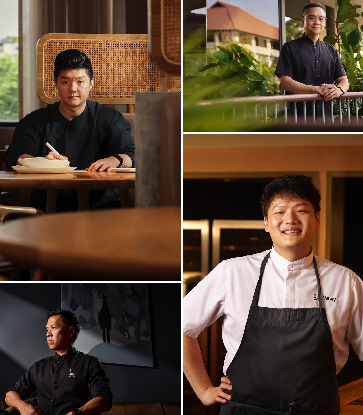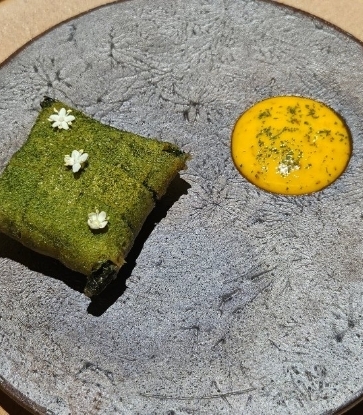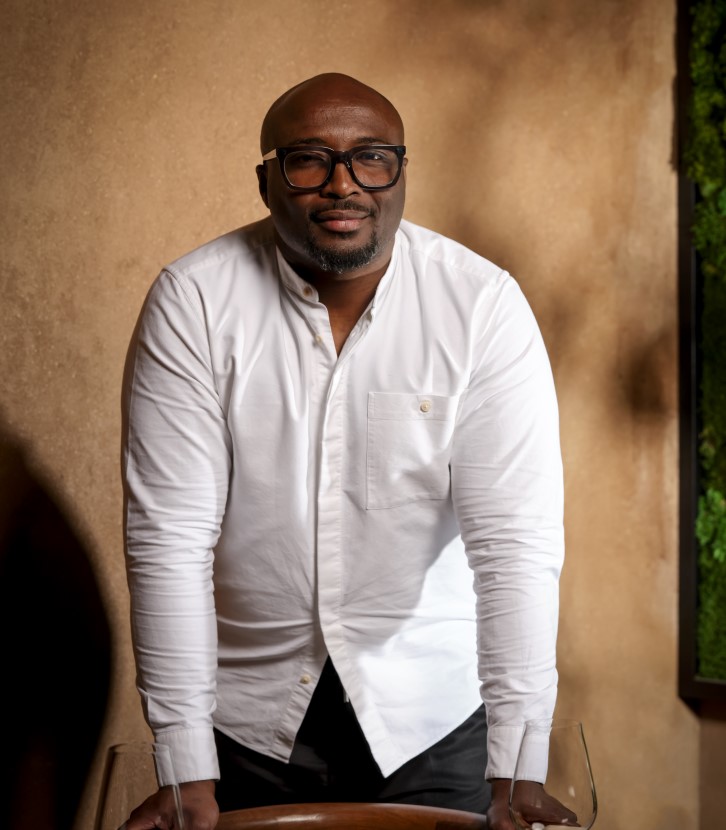Newly bestowed with a MICHELIN star, Hamamoto along Tras Street has now become a popular name when it comes to top-tier Japanese food in Singapore. The chef behind the noren, Kazu Hamamoto, is praised by our MICHELIN Guide inspectors for his attention to detail to everything in his restaurants — especially the produce — describing his meticulousness as some kind of obsession.
In this exclusive interview, the Japanese chef discloses his obsession with craftsmanship, his favourite local eats, his most cherished comfort food, and what it takes to run a MICHELIN-starred Japanese restaurant in the Lion City.
In your opinion, what sets Hamamoto apart from other Japanese restaurants in Singapore?
Hamamoto is a modern Japanese restaurant that combines the art of sushi and kaiseki, with a focus on seasonal produce and dishes. My cuisine reflects who I am, where I came from, and the produce I love. Diners can expect the finest produce presented in a multitude of ways. Part of the experience is watching the food being prepared — the fish being sliced, the crab legs being poached... all of this happens at the counter. I feel it brings a different dimension to the dining experience.
Could you please walk us through the Hamamoto experience?
For me, the experience at Hamamoto is centred around the ethos that food replenishes the soul. When my guests come into Hamamoto, I want them to feel that they are in a space dedicated to nourishing them with comfort and care through the best food, drinks, and service. Part of that is procuring and serving what’s in season in Japan. It is important that the produce I use reflects a sense of place, of the care taken to grow what eventually ends up on the plate, and the provenance of the seafood. For example, the flavour of a crab is reflected in where it was caught — cold, pristine waters translate to the sweetest flesh.
More than that, good cooking isn’t just about cooking food that’s in season. We must think about the cycle of the season. It is about understanding the life cycle of the ingredient and knowing how to get the best out of them at the optimum time. That’s what I strive for every day at Hamamoto.
How did your culinary journey start?
Growing up, my mother cooked for us every day. My father loves to eat and he would go fishing often. Whatever fish he brought home, my mother would cook and never let a single part go to waste. She would butcher the fish, make sashimi, braise it, and fry some parts. As a boy, I watched her cook for us, and I knew it was a special thing — something so seemingly quotidian eventually becomes a part of who we are for the rest of our lives.
When I was 11 years old, I watched an episode of Iron Chef, and I was so impressed! I thought, this is what I want to be (laughs). And this also explains why I like there to be some action in my restaurant. When I decided to go to culinary school, my mother was very supportive.
One of my teachers there, Mr. Nakata, became a great influence to me. He is a master of Kyoto cuisine and I watched and followed him carefully. He has dedicated his life to learning this singular craft and has been very active in promoting Kyoto cuisine to the rest of the world, in countries like France, America and Asia. When I was in school, I aspired to be like him.
You are known for your obsession about your ingredients' provenance. How important is the relationship of produce and its source to you?
Because I am Japanese, I use only Japanese produce. To me, that speaks volumes about where the ingredients and the cuisine come from, regardless of the fact that we are far away from Japan. I buy my seafood from a local market in Fukuoka and Tokyo’s Toyosu market. Four times a week, I’m up at 2 a.m. in the morning to watch the live seafood auctions so I can pick the seafood I want. I convey my orders to my vendors (who I have worked with for over 15 years), and they bid on the produce for me. They call me back at 7 a.m. to let me know what we have for that shipment. I get only a few hours’ sleep during those nights, but it’s worth it.
As I said in my earlier, knowing where the produce is from and how it was grown or sourced makes all the difference to flavour. Respecting the intrinsic nature and flavour of the ingredient must follow, because that’s how you showcase the ingredient in the best way — by doing just enough for its natural qualities to shine.
What is it that you want your diners to remember Hamamoto for?
I want them to be transported to whatever season it is in Japan. Hamamoto is a sushi and kappo restaurant, so the food is always finished in front of guests. I like this style of service because I want my guests to experience the action in the kitchen with us.
What is your personal favourite fish to use for sushi and why?
For sushi, I like to use sea bream. Growing up in Wakayama, sea bream was everywhere. My father liked to eat it mixed with rice. As a child, I didn’t like sea bream because I felt it was tasteless. But once I became a chef, I realised that fish is better when you’ve aged it. Today, I age sea bream for a week before I serve it as sushi. The flavour that develops during that week takes it to a new dimension, and it goes really well with rice, which reminds me of how my father liked to eat it.
What do you consider to be the signature dish at Hamamoto?
We have a seasonal shellfish dish where the main protein is crab, shrimp, or lobster, depending on the season. We top that with caviar and uni. I have always liked this combination of three different textures and flavours that work so well together.

Tell us about your first encounter with the MICHELIN Guide, and what influence has it had over your career?
When I was in culinary school in 1999, my teacher told us about the MICHELIN Guide. He said that it's the most powerful guide started by a tire company, and I thought it was interesting. He told us how the inspectors would come into the restaurants incognito to judge. I thought, maybe one day an inspector would visit my future restaurant, but I knew I had to work very hard to get there.
What did you feel when you found out that Hamamoto was recognised with its first MICHELIN Star?
I was very happy and humbled. There is also a sense of pressure because you want to keep the star and live up to heightened expectations. Most of all, I was proud because my team and I work very hard for it.
How did you and the team celebrate?
After the MICHELIN Gala Dinner, we went to a Chinese restaurant to celebrate as a team.
Is there anyone you would like to dedicate this recognition to?
My team. I would not have accomplished this without them.
What is your message to other local chefs who want to achieve a similar goal as you?
You must have passion for your work. There is no shortcut to success. You get up and do your job every day and do the best you can. It is also very important to believe in yourself.
What does Hamamoto’s MICHELIN Star mean to you?
It means that people recognise the work that goes into what we do, and we are very grateful for it. It has also put us on the map internationally, as more people from outside Singapore know about us now. More than that, it is poignant because being recognised with a MICHELIN star has been a lifetime dream come true for me. It is a beautiful symbol that reminds my team and I that the hard work is worth it and that our customers enjoy and appreciate what we do.
What do you think is the most important quality that a chef should have?
Perseverance. You have to be consistent every day, whether you are sick, tired or hungover. You just have to keep going.

How long have you been in Singapore and how has Singapore become your “home away from home”?
I’ve been here for 13 years. The truth is my world is very small in Singapore. Most of my time is spent in my restaurant. So I see the best of Singapore in my children, who have developed many Singaporean traits, like their love for chicken rice.
What are your favourite local dishes and how do you like to relax?
I like chicken rice, laksa, and Hokkien mee. Actually, I love most Singaporean food. The only thing I don’t like is durian. To unwind, I go to the gym because to me, exercise refreshes the mind and body. I often go in the morning, but sometimes, I will go after service, late at night.
Any comfort foods to share?
Natto (fermented soybeans), Japanese rice, and a raw egg. It’s simple and very tasty. Every day, I make it a point to taste the fish and all the ingredients that I serve, so in that sense, I eat well. So, when I can sit down and have a meal, I just want the simple comforts of natto, rice and an egg.
What is the best lesson you’ve learned so far in the course of your career?
That I have to take care of myself in order to deliver a consistent experience for my guests. With Japanese cuisine, you are basically doing the same thing every day. But at the same time, everything is different, especially when you consider the seasonal produce we work with. It can be a challenge to ensure that our guests feel like they experience something new each time they return to Hamamoto, but that is what we want to deliver: a unique and memorable experience each time. The work is gruelling and that’s why I make it a point to go to the gym regularly and to eat simply. These ensure that I take care of myself so that I can push further.
What’s next for Kazu Hamamoto?
We are striving for a second MICHELIN star. There is always room for us to do better. We want to be able to give our guests a truly exceptional and meaningful experience every time they come to Hamamoto.
Hamamoto is located at 58 Tras Street, 078997, Singapore. Book a table here.





















